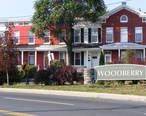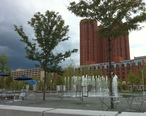Baltimore is the largest city in the U.S. state of Maryland, and the 30th-most populous city in the United States.
Baltimore was established by the Constitution of Maryland and is an independent city that is not part of any county.
With a population of 617,734 in 2017, Baltimore is the largest independent city in the United States. As of 2016, the population of the Baltimore metropolitan area was estimated to be just under 2.8 million, making it the 21st largest metropolitan area in the country.
Baltimore is located about 40 miles northeast of Washington, D.C., making it a principal city in the Washington-Baltimore combined statistical area (CSA), the fourth largest CSA in the nation with a calculated 2016 population of 9,665,892. Founded in 1729, Baltimore is the second-largest seaport in the Mid-Atlantic.
The city's Inner Harbor was once the second leading port of entry for immigrants to the United States and a major manufacturing center. After a decline in major manufacturing, industrialization, and rail transportation, Baltimore shifted to a service-oriented economy, with Johns Hopkins Hospital (founded 1889) and Johns Hopkins University (founded 1876), now the city's top two employers. With hundreds of identified districts, Baltimore has been dubbed a "city of neighborhoods".
Famous residents have included writers Edgar Allan Poe, Edith Hamilton, Frederick Douglass, and H. L. Mencken; jazz musician James "Eubie" Blake; singer Billie Holiday; actor and filmmaker John Waters; and baseball player Babe Ruth. In the War of 1812, Francis Scott Key wrote The Star-Spangled Banner, which later became the American national anthem, in Baltimore.
Baltimore has more public statues and monuments per capita than any other city in the country, and is home to some of the earliest National Register Historic Districts in the nation, including Fell's Point, Federal Hill, and Mount Vernon, which were added to the National Register between 1969–1971. Close to a third of the city's buildings (over 65,000) are designated as historic in the National Register, which is more than any other U.S. city.
reviews (667)
Yes i would, my neighborhood is quite quiet, there is not much that goes on, and the people around here are friendly. There are grocery stores, hair stores, and clothes stores not even a 10 minute walk from here .
My neighborhood is not the best.
I have a recoving stroke family member
Very sage community friendly neighbors





















































I have been working in Health care for years my last job HCH LLC.i taken care of my mother for 5yrs, I am foster care mom I love taking care of people